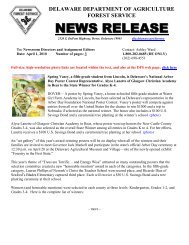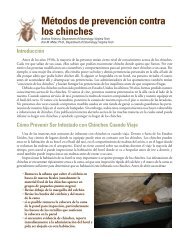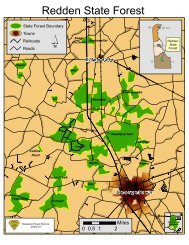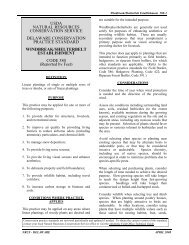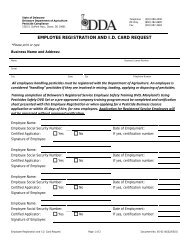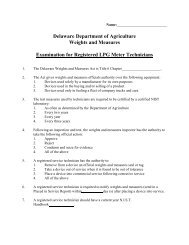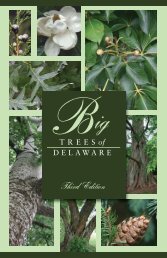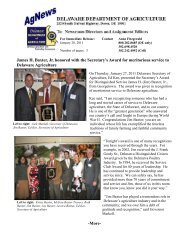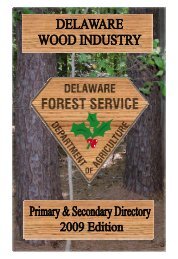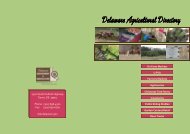DFS Resource Assessment - Delaware Department of Agriculture
DFS Resource Assessment - Delaware Department of Agriculture
DFS Resource Assessment - Delaware Department of Agriculture
You also want an ePaper? Increase the reach of your titles
YUMPU automatically turns print PDFs into web optimized ePapers that Google loves.
Figure 29. Forest Legacy Areas.<br />
Figure 30. Active CFPA Enrollment, 1995 and 2005.<br />
35,000<br />
30,000<br />
25,000<br />
20,000<br />
15,000<br />
10,000<br />
5,000<br />
0<br />
21,625 29,000<br />
1995 2010<br />
Source: <strong>Delaware</strong> Forest Service.<br />
Source: <strong>Delaware</strong> State Agency reporting.<br />
Additional forestlands are protected within <strong>Delaware</strong><br />
through ownership by nongovernmental organizations<br />
(NGOs) with environmental protection missions. While<br />
many <strong>of</strong> these lands are not permanently restricted from<br />
land use conversion through conservation easements, it is<br />
very likely that these forests will remain permanently<br />
protected. NGOs own over 16,000 acres <strong>of</strong> forestland; two<br />
organizations own the bulk <strong>of</strong> these lands – <strong>Delaware</strong><br />
Wildlands, Inc. (over 11,000 acres) and The Nature<br />
Conservancy (over 4,000 acres).<br />
Much <strong>of</strong> <strong>Delaware</strong><br />
enjoys extremely low<br />
property taxes –<br />
some <strong>of</strong> the lowest tax<br />
per assessed value in<br />
the eastern United<br />
States. Nonetheless,<br />
<strong>Delaware</strong>’s Commercial<br />
Forest Plantation Act<br />
(CFPA) <strong>of</strong>fers a 30-year<br />
county tax exemption to<br />
landowners with at least<br />
10 acres <strong>of</strong> forestland<br />
and who follow a forest<br />
stewardship plan. In<br />
2010, 29,000 acres <strong>of</strong><br />
private forests were<br />
enrolled in CFPA; this<br />
is over 10 percent <strong>of</strong><br />
<strong>Delaware</strong>’s privately owned forestland. The period from<br />
1995 through 2010 saw a roughly 34 percent increase in<br />
CFPA acreage (Figure 30).<br />
Additional forestland is enrolled in the state’s Farmland<br />
<strong>Assessment</strong> Program that provides a significant property<br />
tax reduction (<strong>of</strong>ten a complete exemption from property<br />
taxes) for agricultural land that generates a minimum<br />
amount <strong>of</strong> gross receipts averaged over a two-year period.<br />
Many woodlots that are associated with cropland are<br />
included in this property tax program. Currently, the <strong>DFS</strong><br />
estimates there are approximately 75,000 acres <strong>of</strong><br />
forestland enrolled in the Farmland <strong>Assessment</strong> Program.<br />
(As <strong>of</strong> December, 2009 New Castle County reported<br />
7,573 acres and Kent County reported 30,231 acres <strong>of</strong><br />
forestland enrolled. Sussex County only tracks total<br />
acreage (184,626); therefore, assuming 20 percent <strong>of</strong> these<br />
lands are forested – believed to be a reasonable estimate<br />
<strong>of</strong> the forested percentage <strong>of</strong> farms – yields an estimated<br />
37,000 acres enrolled in Sussex County.) There is no<br />
additional requirement, such as a forest management plan,<br />
for landowners with forestland within the Farmland<br />
<strong>Assessment</strong> program.The Sustainable Forestry Initiative<br />
(SFI), a program developed by the American Forest and<br />
Paper Association, provides certification for forestlands<br />
with management plans that meet certain sustainability<br />
criteria. The Glatfelter Pulp Wood Company, a private<br />
landowner, owns and manages over 8,900 SFI-certified<br />
acres in <strong>Delaware</strong>. Also, the 1,350 acres <strong>of</strong> forestland<br />
owned by the Forestland Group are certified through the<br />
Forest Stewardship Council (FSC).<br />
Conclusions:<br />
Over 85 percent <strong>of</strong> <strong>Delaware</strong>’s forests are privately<br />
owned; the remaining publicly owned forests are in state<br />
ownership with some federal and minimal county/local<br />
ownership. Therefore, programs designed for private nonindustrial<br />
forest landowners will continue to be the most<br />
common method to protect forests from conversion to<br />
other uses. There are a variety <strong>of</strong> conservation easement<br />
programs that have protected over 30,000 acres <strong>of</strong><br />
forestland in <strong>Delaware</strong>. NGOs also have protected<br />
significant forested acreage. While <strong>Delaware</strong>’s county<br />
property taxes are quite low, the Commercial Forest<br />
36 <strong>Delaware</strong> Forest <strong>Resource</strong> <strong>Assessment</strong>



